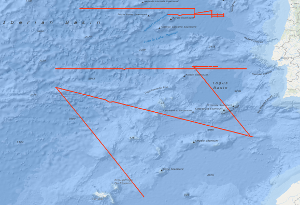The main purpose of the cruise SO75 from 14th October to 12th November 1991 was to test the new instrumentation of the SONNE and the ship itself for the needs of marine geophysics. The second purpose was the investigation of the crustal structure of the Atlantic Ocean from the Madeira-Torre Rise to the continental slope of Portugal which is conjugate to the margin off Newfoundland being investigated by a previous BGR cruise (Hinz et al., 1989). Methods used were multichannel reflection seismics, gravimetry, magnetics, swath echosounding and sediment echography. The test of the ship and its result is discussed in a separate technical report (Roeser et al., 1991). On two lines crossing the Madeira-Torre Rise we have observed seaward dipping reflector sequences. Their position is conjugate to similar features observed off Newfoundland. Magnetic models for one line show a strong magnetization of the whole reflector sequence. Thus, in analogy to the drilled dipping reflector sequence on the Vøring Plateau, it is likely that it mainly consists of lava flows which were extruded subaerially or in shallow water. In contrast to the dipping reflector sequences found earlier, the newly detected sequences are far away from continental crust. Presumably, at the time of their formation the Midatlantic Ridge was subaerial. Geometrical constraints indicate a compressional regime for the eastern part of the Azores-Gibraltar Fracture Zone. Most prominent expression of this is the Gorringe Bank. Our seismic line across it indicates an overthrusting of oceanic crust, however, it does not show any evidence for a Benioff zone. Therefore, only a small amount of oceanic crust can be subducted until now. We have observed compressional features also in the Tagus Abyssal Plain. Our lines north of the Azores-Gibraltar Fracture Zone did not confirm the weak indications for a continuation of the magnetic anomaly M0 across the fracture zone. The present platetectonic models for this area require therefore a modification. For the definition of the ocean-continent transition in the Iberia Abyssal Plain and for the investigation of the nature of the crust near the transition zone 6 ODP drillsites have been proposed. In response to a request by R.B. Whitmarsh from the Institute of Oceanographic Sciences at Wormley, Godalming, we have carried out the required ODP Site Survey. Hauptzweck der Fahrt SO75 vom 14. Oktober bis zum 12. November 1991 war der Test der neuen Geräteausstattung der SONNE und des Schiffes selbst für die Anforderungen der marinen Geophysik. Weiterer Zweck war die Untersuchung der Krustenstruktur des Atlantik zwischen dem Madeira-Torre-Rücken und dem portugiesischen Kontinentalhang, der konjugiert zu dem bei einer früheren BGR-Fahrt untersuchten Kontinentalhang von Neufundland ist (Hinz et al., 1989). Eingesetzt wurden Mehrkanalreflektionsseismik, Gravimetrie, Magnetik, Fächerecholot und Sedimentechographie. Auf zwei Profilen über den Madeira-Torre-Rücken haben wir Folgen seewärts einfallender Reflektoren gefunden. Ihre Position ist konjugiert zu ähnlichen Strukturen, die vor Neufundland beobachtet worden sind. Magnetische Modelle für eine der Linien zeigen, dass die Folge aus kräftig magnetisierten Gesteinen besteht. In Analogie zu der auf dem Vøring-Plateau erbohrten Folge bestehen sie wahrscheinlich vorwiegend aus subaerisch oder in flachem Wasser ausgeflossenen Laven. Im Unterschied zu den früher gefundenen Dipping-Reflector-Folgen liegen die jetzt gefundenen weitab von kontinentaler Kruste. Wahrscheinlich war der Mittelatlantische Rücken zur Zeit ihrer Entstehung an dieser Stelle subaerisch. Aufgrund der Geometrie des Nordatlantik unterliegt die Kruste im östlichen Teil der Azoren-Gibraltar-Bruchzone einer Kompression. Deutlichster Ausdruck dieser Kompression ist die Gorringe-Bank. Unser seismisches Profil über diese Bank deutet zwar auf eine Überschiebung ozeanischer Kruste hin, zeigt aber keine Anzeichen einer Benioff-Zone. Deshalb kann, wenn überhaupt, bisher nur wenig ozeanische Kruste suhduziert sein. Kompressionsstrukturen beobachten wir übrigens auch in der Tagus-Tiefsee-Ebene. Zur Untersuchung der Lage der Übergangszone zwischen ozeanischer und kontinentaler Kruste und des Krustenaufbaus sind in der Iberischen Tiefsee-Ebene 6 Bohrpunkte vorgeschlagen worden. Auf eine Anfrage von Dr. R.B. Whitmarsh vom Institute of Oceanographic Sciences in Vormley, Godalming hin haben wir den noch erforderlichen ODP-Site-Survey durchgeführt.





